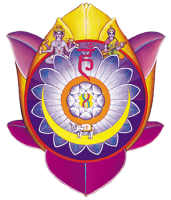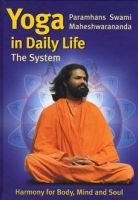Meditations with Specific Influence on the Vishuddhi Chakra
- Sit comfortably and erect, and relax your body. (If you are unable to sit comfortably on the floor then sit in a chair.) Close your eyes. Feel yourself happy, relaxed and free.
- Inhale and exhale deeply a few times, and through this deepen the relaxation more and more.
- Do not concentrate; remain without imagination. Be conscious only of yourself, and say to yourself: “I want to relax completely”.
- Relax the jaw, the lips, eyelids, forehead and cheeks. Try to relax your face muscles completely.
- Relax the shoulders, arms and hands.
- Relax the back muscles, abdominal muscles, legs and feet.
- Relax the whole body from the toes to the head, and from the head to the toes.
- Now direct your attention to the centre of the chest, the Anāhata Chakra. Remain completely relaxed.
- Analyse your thoughts without condemning anything. Be totally conscious of your thoughts; observe their coming and going; push nothing away and hold onto nothing.
- Relax the whole body – relax – relax.
- Now direct your consciousness to the process of breathing. Feel the breath flowing in and out. Allow your breath to flow freely.
- Now place the index and middle fingers of the right hand at the base of the throat between the collarbones. With this do not exert any pressure (If the arm becomes tired you can change hands).
- Relax the head and the neck. Do not look upward behind your closed eyes rather look slightly down as if you were reading a book. Remain completely quiet, without expectations. Merely observe, and let come what comes.
- Breathe a little deeper than normal and observe your breathing. Feel the warmth of your fingers and the whole body.
- Now immerse yourself in your inner space and visualise your present life up until now as if it were a film running. Be honest and follow mentally the course of events. Each image, each recollection should arouse exactly the same feeling as when you actually experienced the situation.
- This exercise arouses painful, but also beautiful, feelings within us. Allow it to be as it is and simply observe everything.
- Go back as far as you can remember. Generally the negative experiences rise first into the consciousness. Continue on unwaveringly. Remember, feel and experience the pain, disappointments and fears of that time again with full consciousness. From what have you suffered? Today, yesterday, the day before yesterday, last week, over the last month. You can either go backwards from the present time into the past, or progress from your childhood up to the present day. Many insignificant events pass through the mind, but suddenly there is a point at which you falter. Stay there with full awareness and dive deeper. Experience the events again clearly.
- Feel that you are not alone. God and your Master are there and hold your hand. Do not be afraid, you are protected and accompanied.
- Go deeply within and experience that from which you have suffered.
- After you have performed this exercise for about 15 minutes, place your hands on your knees, bend forward slightly and press the chin against the sternum (Jālandhara Bandha).
- Feel the breath flowing through your throat.
- Return your consciousness to the experience you have been dealing with.
- With the inhalation imagine that you received that which you needed at that time (care, comfort, help, love …….)
- With the exhalation release everything that caused you pain at that time.
- Exhale the dark and painful memories and inhale light, happiness and liberating feelings.
- Release the painful experiences, because to give freedom means to attain freedom.
- Perform this exercise for about 15 minutes.
- Then slowly raise the head and remain sitting relaxed.
- Let the practice continue to have an effect and observe your inner world. The time has passed, but the feelings and injuries from earlier times are still always deep within you. Hold nothing back; look within yourself without fear. Try to understand your life. Why was I born? What should I achieve in this life? What is my life’s work, my Dharma? Through concentration on the Vishuddhi Chakra the answers to these questions open for you.
Meditation 2
- Sit in a comfortable, upright meditation pose.
- Perform Jālandhara Bandha (see above) and at the same time roll the tongue backwards so that it touches the soft part of the palate (Khecharī Mudrā). Breathe a little deeper than normal.
- Connect the inhalation with the Mantra SO and the exhalation with the Mantra HAM. SO HAM means “That am I, I am that”.
- If the position of the tongue becomes uncomfortable relax it for a while and then again assume Khecharī Mudrā.
- Continue to repeat the Mantra SO HAM. Your body remains completely relaxed.
- Now ask yourself inwardly what desires and illusions remain unfulfilled in your life. What injuries and disappointments do you permanently carry within you? Do the feelings of loneliness and sorrow exist within you? What do you want? What are you seeking?
- On the other hand be aware of what joy, beauty, peace, happiness, harmony, balance, warmth and security exist within your inner Self.
- Have you found what you are looking for? Do you know where you belong?
- Analyse yourself; be an observer of your inner world. Allow everything to come. By the power of your breath in the Vishuddhi Chakra and the Mantra you purify all thoughts and emotions.
- After about 10 minutes release Jālandhara Bandha and relax the Vishuddhi Chakra.
- Leave your eyes closed. Relax your abdomen, shoulders, arms and jaw and dive anew into the inner field of your life.
- Discover your inner reality. Do not run away or evade the issue. How long have you been trying to escape from your inner truth?
- Be clear, honest and open with yourself. There is certainly a solution to anything unpleasant you push aside. And, for sure, there is also a possibility that beautiful and happy feelings can unfold within you and you can transfer these to others.
- Inhale and exhale deeply.
- Sing OM three times and the Peace Mantra – SHĀNTIH – SHĀNTIH – SHĀNTIH.
- Rub the palms of your hands together, place your hands on your face and warm your eyes and face muscles.
- Open your eyes, fold your hands in front of your chest and bend forward until your forehead touches the floor.
Meditation 3
- Sit in a comfortable meditation position. Close your eyes and slowly withdraw from the outer world.
- Do not concentrate or have any expectations. Relax. Feel you are protected, safe and well.
- Now direct your attention to your body. Be conscious of your mental and physical presence in the room. Remain “here” and simply be an observer. Do not allow yourself to be carried away by your thoughts.
- Feel your whole body from the toes to the top of the head, and from the head to the toes. Be aware of the motionlessness of your body. Relax.
- Now direct your attention to the process of breathing. Allow the breath to flow completely naturally. Be aware of each inhalation and exhalation. Feel the breath flowing through the nose and the throat.
- Feel happy that you are able to breathe freely. Visualise the breath as a fine thread of light – a thread of divine energy. a ray of light that leads you to your source. In the breath flows the energy of the Divine Mother who nourishes your soul. Through your breath you are constantly connected to God on the physical level. You inhale fresh energy and vitality and exhale used energy and toxic substances.
- Expand your consciousness into infinity. See your inner space filled with rays or sparks of light. These rays and sparks of cosmic energy (Prāna Shakti) are constantly drawn into your heart centre.
- Your breath is now slightly deeper than normal. You inhale and exhale rays of light. You are the centre through which the light of life flows without interruption.
- Your inner world exists in the space of your heart (Hridayākāsha). Here is the world of your feelings, here your past and present consciousness meet in order to prepare the path for the future.
- How do you wish your future to be? Where do you want to go? What have you done towards this up until now?
- Now allow your consciousness to rise from the Anāhata Chakra to the Vishuddhi Chakra. Place the index, middle and ring fingers softly between the collarbones, where the throat begins. Bend your head forward slightly and feel how the energy, the light, streams into the Vishuddhi Charka and continues to flow into infinity.
- Your inner space is infinite. You begin to free yourself. This disengagement can be experienced as pleasant, but also as unpleasant and painful. Sometimes we experience it as beneficial, but sometimes as loss and painful renunciation. Why does renunciation often make us unhappy? Because we are unable to let go. It is our attachment that creates the unhappiness and pain. However, where beautiful and positive feelings of love, devotion and clarity prevail, there flows bliss – Ānanda.
- In your inner space experience the purification of the Vishuddhi Chakra. Lie your whole palm on your chest. Visualise your hand radiating divine power and love. It protects you and gives you inner warmth. The radiation of your hand has an activating influence on the Vishuddhi Chakra and at the same time quietens the emotions in the Anāhata Chakra. Do not allow yourself to be swept away by the emotions, but experience them with full consciousness. Feel the touch and warmth of your hand and allow the energy to flow into you.
- Be honest with yourself and examine the problems that are now confronting you. Try to gain clarity about it, about what disturbs you, and about what you are able to change in your life. Do not run away, but stay in your inner space. Everything that happens is within you – and the solution for your problems you will also find within yourself.
- Continue this exercise for about 15 minutes.
- Feel yourself totally free and pure. Inhale and exhale purity and feel how the entire atmosphere around you is purified.
- Now come slowly into contact with the outer world again. Inhale and exhale deeply once, and move your body.
- Then sit on your heels and come into Shashankāsana, inhaling as you stretch your arms above your head and exhaling as you bend the body forward until the arms and head touch the floor. Continue to breathe normally and remain in this position for as long as is comfortable for you. This Āsana calms the mind and helps clarify the thoughts.


